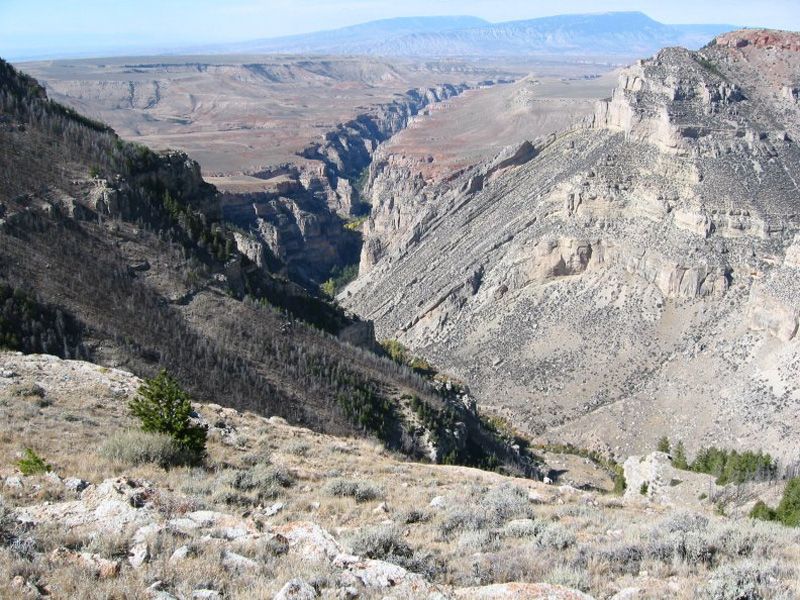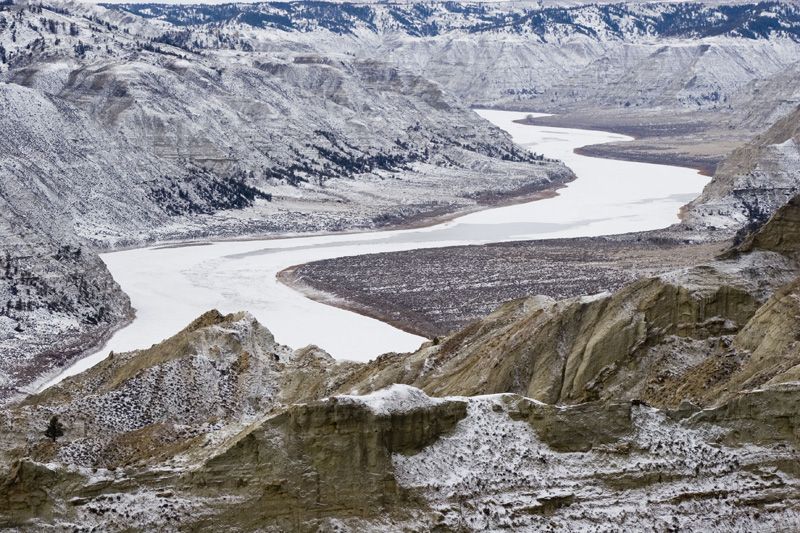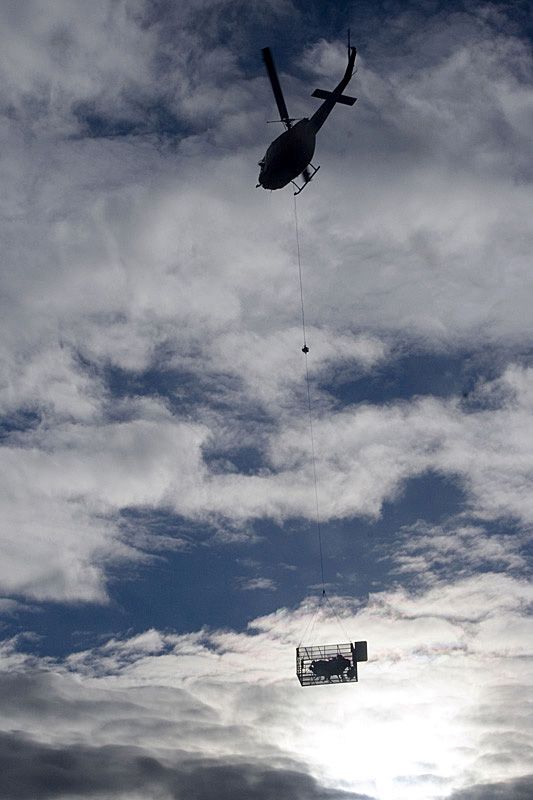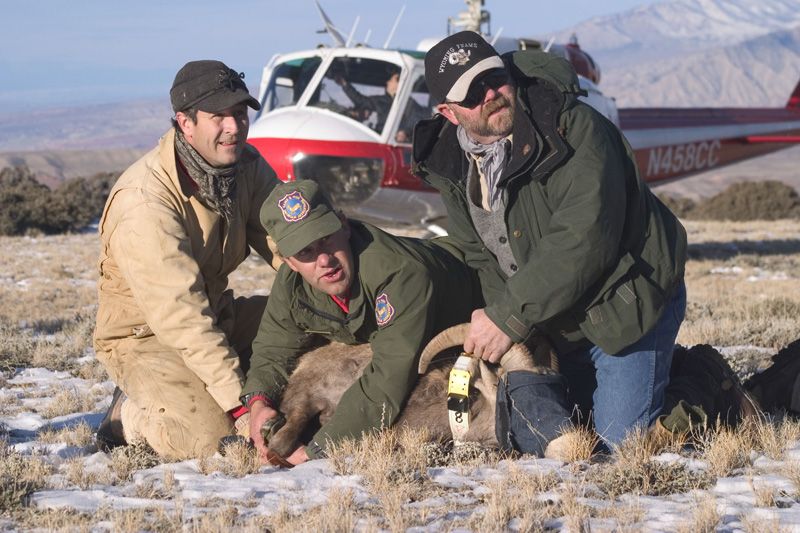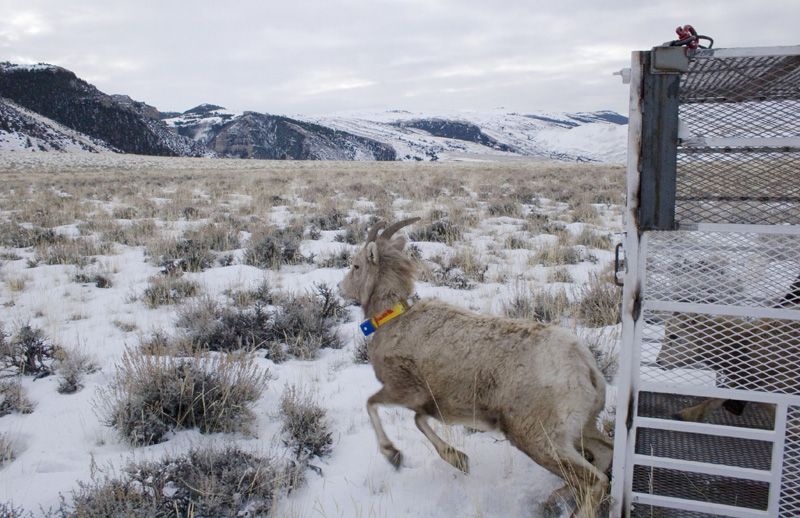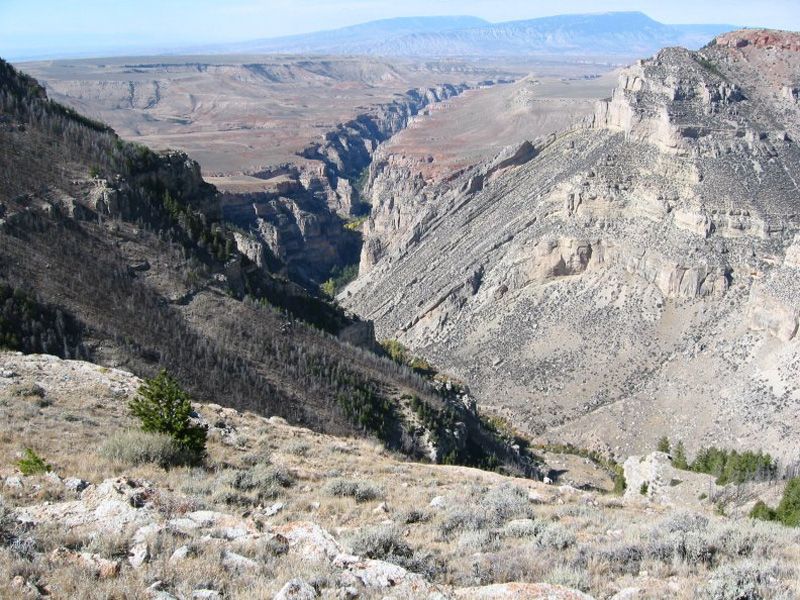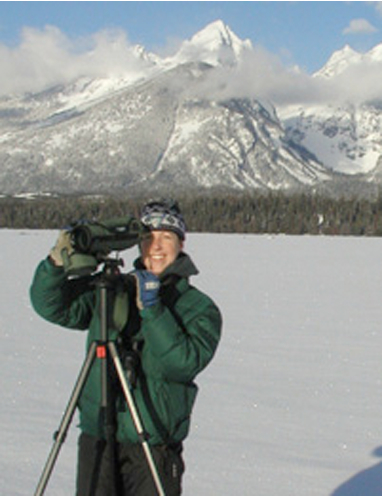Over the past 120 years, many bighorn sheep (Ovis canadensis) herds throughout Wyoming and the Rocky Mountain west have declined or been extirpated due to disease, habitat loss and fragmentation, and competition with domestic sheep. Since 1934, Wyoming has conducted a number of bighorn sheep reintroduction efforts into historically occupied ranges, which are commonly xeric, canyon habitats. Most Wyoming transplants utilize bighorn sheep from a source herd on Whiskey Mountain, near Dubois, Wyoming. Bighorn sheep from this herd are migratory and adapted to summering in high-elevation alpine habitat.
In general, transplants into Wyoming have resulted in herds with low productivity, which is potentially due to a mismatch between Wyoming habitats and source herd foraging strategies and habitat preferences. We examined habitat selection strategies of resident bighorn sheep in Devil’s Canyon, Wyoming (transplanted from Whiskey Mountain in 1973) and of two source herds transplanted into the same area from the lower Deschutes River, Oregon in December 2004 and the Missouri River Breaks, Montana in January 2006. Oregon and Montana bighorn sheep originated in semi-arid habitats and were expected to be better suited for the habitat types of Devil’s Canyon. We used global positioning system (GPS) locations collected from radio-collared resident bighorn sheep (n=9 [6 adult ewes, 3 adult rams]), and transplanted Oregon (n=6 [5 adult ewes, 1 adult ram]) and Montana (n=11 [9 adult ewes, 2 yearling rams]) bighorn sheep to evaluate habitat selection.
Analyses modeled the relative probability of use of each group as a function of habitat attributes using a design II resource selection function (RSF). Model coefficients suggested that distance to escape terrain and the limber pine – juniper – mahogany, big sagebrush, and mixed grass – sage prairie vegetation classes were significant predictors of bighorn sheep relative frequency of use for all three source herds. Inter-herd differences existed for distance to escape terrain and the use of mountain mahogany and mixed grass – sage prairie vegetation classes, indicating that source herds use habitat features slightly differently due to unique genetic or learned aspects of foraging behavior. Predictive maps of relative probability of use for each source herd suggested that Montana bighorn sheep are able to utilize the greatest variety of habitats, whereas Wyoming and Oregon bighorn sheep distributions are more restricted.
Analyses of spatial association among transplanted sheep indicated that rams from each source herd were coming into close association (within 150 m) with ewes from other source herds. Such association was especially evident during the autumn breeding season. Network diagrams were constructed to illustrate the spatial associations of all collared animals.
These findings suggest that transplanted bighorn sheep originating from different habitats exhibit subtle but detectable differences in habitat selection strategies, but such differences are unlikely to prevent interbreeding. Demographic research is needed to determine whether these habitat selection differences influence productivity and reintroduction success.
This analysis was a collaboration between our research group, the Wyoming Game and Fish Department, and the Department of Zoology & Physiology at the University of Wyoming. Earlier stages of the project, including bighorn sheep transplants, GPS-collaring, lamb monitoring, predator management, and prescribed burns were made possible with the help of numerous funding partners and cooperators.
Gallery
Reports & Publications
Kauffman, M.J., A.B. Courtemanch, A.B. Rutledge, K.P. Hurley, T.G. Easterly, and D.B. McDonald. In prep. Habitat selection and group association of translocated bighorn sheep (Ovis canadensis) in north-central Wyoming: does source herd matter?
Project Presentations
Kauffman, M.J., A.B. Courtemanch, A.B. Rutledge, K.P. Hurley, T.G. Easterly, and D.B. McDonald. Habitat selection of transplanted bighorn sheep in north-central Wyoming: Does source herd matter? 90th Annual Meeting of the American Society of Mammalogists. Laramie, WY. 13 June 2010.
Kauffman, M.J., A.B. Courtemanch, A.B. Rutledge, K.P. Hurley, T.G. Easterly, and D.B. McDonald. Habitat selection of transplanted bighorn sheep in north-central Wyoming: Does source herd matter? 17th Biennial Symposium of the Northern Wild Sheep and Goat Council. Hood River, OR. 11 June 2010.
Kauffman, M.J., A.B. Courtemanch, A.B. Rutledge, K.P. Hurley, T.G. Easterly, and D.B. McDonald. Resource selection of transplanted bighorn sheep (Ovis canadensis) in north-central Wyoming, USA: Does source herd matter? 5th World Conference on Mountain Ungulates. Granada, SPAIN. 11 November 2009.
Kauffman, M.J., A.B. Courtemanch, A.B. Rutledge, K.P. Hurley, T.G. Easterly, and D.B. McDonald. Resource selection of transplanted bighorn sheep (Ovis canadensis) in north-central Wyoming, USA: Does source herd matter? Annual meeting of the Wyoming Chapter of the Wildlife Society. Cody, WY. 4 November 2009.
Contact
Alyson Courtemanch, M.S. candidate
Wyoming Cooperative Research Unit
Dept. 3166, 1000 E. University Avenue
Laramie, WY 82071
[email protected]
lab: (307) 766-6415
cell: (207) 441-2692
Aaron Rutledge, M.S. candidate
Wyoming Cooperative Research Unit
Dept. 3166, 1000 E. University Ave.
Laramie, WY 82071
[email protected]
office: (307) 766-6415
Kevin Hurley, Conservation Director
Wild Sheep Foundation
720 Allen Ave.
Cody, WY 82414
[email protected]
office: (307) 527-6261
Tom Easterly, Wildlife Biologist
Wyoming Game & Fish Department
2820 State Highway 120
Cody, WY 82414
[email protected]
office: (307) 527-7125
Project Lead
Alyson Courtemanch is currently an M.S. student in the Wyoming Cooperative Fish & Wildlife Research Unit at the University of Wyoming. Aly earned a B.S. in Biology and Environmental Studies from St. Lawrence University in 2005.
Timeline
- In March 2004, six ewes were captured in Devil’s Canyon and fitted with GPS collars. These individuals were offspring from the original 1973 transplant.
- In December 2004, twenty bighorn sheep (14 ewes, 3 lambs, 3 rams) were transplanted into Devil’s Canyon from the Deschutes River area in Oregon. Ten ewes and two rams were GPS-collared when released.
- In January 2006, twenty bighorn sheep (13 ewes, 5 lambs, 2 yearling rams) were transplanted from the Missouri River Breaks in Montana. Ten ewes and two yearling rams were GPS-collared when released.
- Habitat selection analysis at the Wyoming Cooperative Fish & Wildlife Research Unit began in September 2008.
- Final project report was submitted to the Wyoming Game & Fish Department in April 2009.
Funding & Partners
Wyoming Game & Fish Department · Wyoming Governor’s Big Game License Coalition · Wyoming Chapter of the Wild Sheep Foundation · Wyoming Wildlife and Natural Resource Trust · Bowhunters of Wyoming · Grand Slam Club/Ovis · Wyoming Animal Damage Management Board
Project Cooperators
Wyoming Game & Fish Department · Wildlife Heritage Foundation of Wyoming · Bighorn National Forest · Bureau of Land Management, Cody Field Office · E.O. Bischoff Land & Cattle · USDA/APHIS/Wildlife · Oregon Department of Fish & Wildlife · Montana Department of Fish, Wildlife, and Parks · Bighorn Canyon National Recreation Area, National Park Service · University of Wyoming



